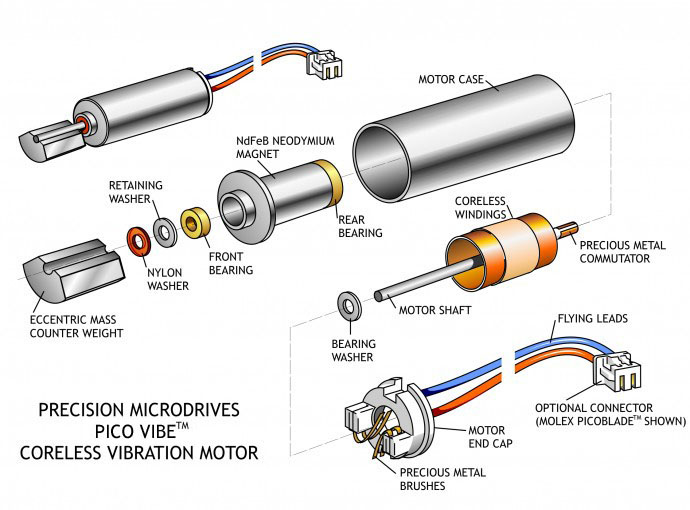ERM
ERM stands for eccentric rotating mass and relies on small unbalanced mass attached to the DC motor axle that creates a displacement force when rotating.
ERM types
All categories were made up in the context of applying them in SenseShift
Coin ERMs
The main advantage of Coin ERMs is their size — Coin ERMs are typically very small, in exchange for very weak feedback.
Coin ERMs drove with 3V, but can be operated with 5V, though drawing much more current.
A demonstration of an opened coin ERM from Tech Vision. There is another great video looking at a coin ERM with a microscope by Marty Jopson.
Verified sources
| Region | Links |
|---|---|
| Global | AliExpress (10 pcs) |
| North America | Adafruit |
Cylindrical ERMs
Cylindrical ERMs (also Coreless ERMs) are a step up from Coin ERMs. They provide much stronger feedback, usually drawing the same current as Coin ERMs in exchange for a bigger sizes.

Exploded view of Coreless Vibration Motor by Precision Microdrives
Example Cylindrical ERMs
- KPD7C-0716
Cored ERMs
Cored ERMs provide the strongest feedback of them all, in exchange for their bulky size and larger current draw. Cored ERMs often rely on brushes, which may cause sparks.

Exploded view of Cored DC Motor
Example Cylindrical ERMs
- PS4 Controller (DualShock 4) Rumble Motor
- Xbox One Controller replacement motors (1)
Applying ERMs
There is no strict rules, how to apply different actuators, just a recommendation, based on personal experience.
| ERM type | Feedback Force | Vest | Glove | Facial Interface | Other wearable |
|---|---|---|---|---|---|
| Coin ERM (3V) | Weakest | ❌ | ✅ | ✅ | ✅ |
| Coin ERM (5V) | Weak | ✅ | ✅ | ✅ | ✅ |
| Cylindrical (3V/5V) | Medium | ✅ | ❌ | ❌ | ✅ |
| Cored Motor (3V/5V/12V) | Strong | ✅ | ❌ | ❌ | ❌ |
Wiring ERMs
Most ERM actuators, even the smallest Coin ERMs, draw much more, than safe 20mA, that can be provided by ESP32, so using a transistor is required to wire an ERM actuator.
In most cases, when building DIY SenseShift devices, using ULN2803A Darlington transistor array is the best way since it can power 8 devices at the same time, which pairs nicely with PCA9685 16-channel PWM driver.
Since ERMs rely on PWM signal, following PWM drivers can be used:
- Internal PWM generator
- PCA9685